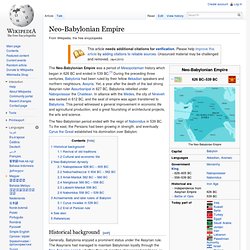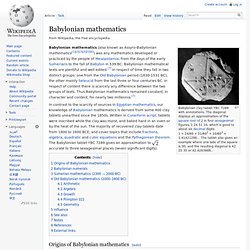

Babylonia. Babylonia was an ancient Akkadian-speaking Semitic nation state and cultural region based in central-southern Mesopotamia (present-day Iraq).

It emerged as an independent state c. 1894 BC, with the city of Babylon as its capital. It was often involved in rivalry with its fellow Akkadian state of Assyria in northern Mesopotamia. Babylonia became the major power in the region after Hammurabi (fl. c. 1792 - 1752 BC middle chronology, or c. 1696 – 1654 BC, short chronology) created an empire out of many of the territories of the former Akkadian Empire. The Babylonian state retained the written Semitic Akkadian language for official use (the language of its native populace), despite its Amorite founders and Kassite successors not being native Akkadians. It retained the Sumerian language for religious use, but by the time Babylon was founded this was no longer a spoken language, having been wholly subsumed by Akkadian. Periods[edit] Neo-Babylonian Empire. The Neo-Babylonian Empire was a period of Mesopotamian history which began in 626 BC and ended in 539 BC.[1] During the preceding three centuries, Babylonia had been ruled by their fellow Akkadian speakers and northern neighbours, Assyria.

Yet, a year after the death of the last strong Assyrian ruler Assurbanipal in 627 BC, Babylonia rebelled under Nabopolassar the Chaldean. In alliance with the Medes, the city of Nineveh was sacked in 612 BC, and the seat of empire was again transferred to Babylonia. This period witnessed a general improvement in economic life and agricultural production, and a great flourishing of architectural projects, the arts and science. Babylonia. Babylonian astronomy. Pythagorean theorem. Babylonian mathematics. Babylonian clay tablet YBC 7289 with annotations.

The diagonal displays an approximation of the square root of 2 in four sexagesimal figures, 1 24 51 10, which is good to about six decimal digits. 1 + 24/60 + 51/602 + 10/603 = 1.41421296... The tablet also gives an example where one side of the square is 30, and the resulting diagonal is 42 25 35 or 42.4263888... Babylonian mathematics (also known as Assyro-Babylonian mathematics[1][2][3][4][5][6]) was any mathematics developed or practiced by the people of Mesopotamia, from the days of the early Sumerians to the fall of Babylon in 539 BC. Babylonian mathematical texts are plentiful and well edited.[7] In respect of time they fall in two distinct groups: one from the Old Babylonian period (1830-1531 BC), the other mainly Seleucid from the last three or four centuries BC.
In respect of content there is scarcely any difference between the two groups of texts. Accurate to three sexagesimal places (seven significant digits). Arithmetic[edit] Plimpton 322. The Plimpton 322 tablet.

Plimpton 322 is a Babylonian clay tablet, notable as containing an example of Babylonian mathematics. It has number 322 in the G.A. Plimpton Collection at Columbia University.[1] This tablet, believed to have been written about 1800 BC, has a table of four columns and 15 rows of numbers in the cuneiform script of the period. This table lists what are now called Pythagorean triples, i.e., integers a, b, c satisfying . Although the tablet was interpreted in the past as a trigonometric table, more recently published work sees this as anachronistic, and gives it a different function.[2] For readable popular treatments of this tablet see Robson (2002) or, more briefly, Conway & Guy (1996).
Provenance and dating[edit] Plimpton 322 is partly broken, approximately 13 cm wide, 9 cm tall, and 2 cm thick. List of kings of Babylon. The following is a list of the kings of Babylonia (ancient southern-central Iraq), compiled from the traditional Babylonian king lists and modern archaeological findings.

The Babylonian King List[edit] The Babylonian King List is not merely a list of kings of Babylon, but is a very specific ancient list of supposed Babylonian kings recorded in several ancient locations, and related to its predecessor, the Sumerian King List. As in the latter, contemporaneous dynasties are listed chronologically without comment. There are three versions, one known as "King List A"[1] (containing all the kings from the First Dynasty of Babylon to the Neo-Assyrian king Kandalanu) and "King List B"[2] (containing only the two first dynasties) and "King List C"[3] (containing the first seven kings of the Second Dynasty of Isin). A fourth version was written in Greek by Berossus. Middle Bronze Age[edit] Early Amorite city-states[edit] Panbabylonism. Panbabylonism is a school of thought within Assyriology and Religious studies that considers the Hebrew Bible and Judaism as directly derived from Mesopotamian (Babylonian) mythology.

Appearing in the late 19th century, it gained popularity in the early 20th century, advocated notably by Alfred Jeremias. The ideas presented within its framework still carry importance in mythological studies, due to similarities between myths in the comparatively young Bible and much older myths from ancient Mesopotamian mythologies. Creation myths[edit] The Development, Heyday, and Demise of Panbabylonism. Occidental Constellations and Star Names to the Classical Period The Development, Heyday, and Demise of Panbabylonism by Gary D.

Thompson Copyright © 2004-2014 by Gary D. Thompson Return To Site Contents Page.